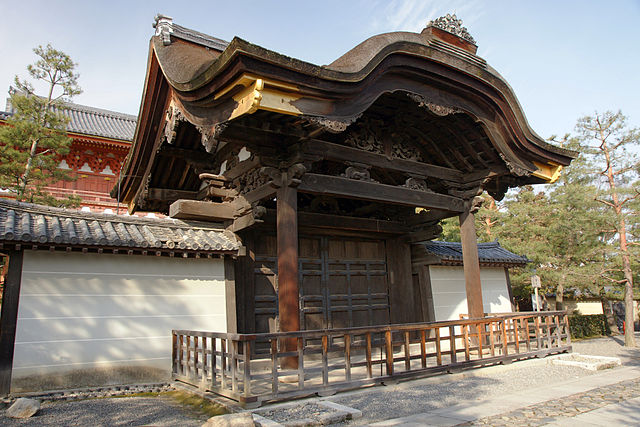
Martin Goodson
‘A Pilgrim’s Guide to Forty-Six Temples' by Shiro Usui
Book Extracts
In this book extract we look at the history of Daitokuji temple, a sometimes controversial yet prolific Zen temple.

Daitoku-ji in Kita-ku, Kyoto, Kyoto Prefecture, Japan
663highland, CC BY-SA 3.0 <http://creativecommons.org/licenses/by-sa/3.0/>, via Wikimedia Commons
Daitokuji is in the Murasakino district in the northern part of Kyoto. Situated in the midst of one of Kyoto’s old densely packed neighborhoods. Its physical dimensions are grand and its buildings are some of the finest in Japan.
Author and novelist Sawako Ariyoshi (1931 - 85) composed an essay on the temple, Thoughts on Daitokuji, from which I quote:
“Passing through the gateway to the temple grounds, there is a large Central Gate to the right. It had recently been repaired; painted a brilliant vermillion, it seemed to soar into the sky. When I looked up at the gate, I felt as if I was looking at a great collection of mysteries. The bright vermilion must be more weathered now, I think, than when it was first painted. But still, what are we to think about a temple gate that is so resplendent that it is almost shockingly excessive. Daitokuji seems to be different from the unsullied Zen forms found here and there on its grounds, which have retained their spartan purity.”
What is this “great collection of mysteries” that Ariyoshi writes of? Seven hundred years have already passed since Shuho Myocho (1282-1337; later known as National Teacher Daito, or Daito Kokushi) built his hermitage here in Murasakino in 1315. Since that time, when the flame of the Buddhist teachings was first lit, there have been rivalries and conflicts between Daitokuji and other well-known Zen temples, as well as between Daitokuji and the political authorities. It was because of its connections to these centers of political authority that Daitokuji became the large and powerful temple center that it did. This was the cause of the temple’s alternating periods of fortune and decline.
Sen no Rikyu (1522-91), the celebrated first grand master of tea, was the person responsible for turning the temple’s, one-story front gate into the three-storied Tower of Golden Down (Kimmokaku), as the gate is also known. He then enshrined an image of himself there. Knowing this, one begins to wonder where the notions of wabi and sabi so essential to the tradition of the tea ceremony, are to be found in this resplendent gate. That is one of the great mysteries of Daitokuji.
Pilgrims to Daitokuji often first recall its founder, Shuho and then also one of Daitokuji’s most famous as well as most unconventional priests Ikkyu Sojun (1394-1481). A trip here also reminds us of many other great Zen thinkers, such as Takuan Soho (1573-1645).
From the thirteenth through to the nineteenth centuries, a constant glimmering flame of the Zen spirit shone amidst the turbulent struggles for authority and wealth that took place at Daitokuji. This is keenly felt when we read the temple histories. Perhaps we ought to think of these struggles as the inevitable complications that arise out of the meeting of the sacred and the profane.
The histories of Daitokuji do not go into detail concerning those struggles, but they are eager to display the temple’s magnificent traditions in the records of daily tea gatherings (chaen) that were, and still are, held here. Daitokuji can perhaps be regarded as the head temple for the practice of the tea ceremony. Serious students of Zen may bypass Daitokuji, but those looking to participate in chaen do not. Historically, there has always been a deep relationship between Zen masters and the tea ceremony. For example, three of the most famous tea masters Juko (1422-1502), Rikyu and Sotan (d. 1658), studied with Ikkyu Kokei (1532-97), and Takuan respectively, all of whom were priests from Daitokuji. But, in essence, who does the world of tea at Daitokuji relate to Zen itself? What does it mean to say that Zen and tea are “one taste”? Perhaps this is what a pilgrimage should attempt to achieve - the unraveling of mysteries; in the case of Daitokuji, we endeavour to grasp the nature of tea and Zen while strolling through the temple grounds.
The monk Nanrei Kobori, head of Ryoko-in, wrote the following about Ikkyu: “Ikkyu regarded obedience to organised authority as dishonest and despised those who lacked the moral courage to resist it. If this attitude is a result of his enlightenment then his fellow Daitokuji monks Daito, Muso and Yoso (?-1428), whom Ikkyu hated, were also men who had attained the same enlightenment. However Ikkyu could not tolerate people with a spirit too weak to say no. Obedience to authority or ingratiation - even if it was passive - was intolerable to him.”
‘A Pilgrim’s Guide to Forty-Six Temples by Shiro Usui (pub. Weatherhill Inc. NY 1990)




